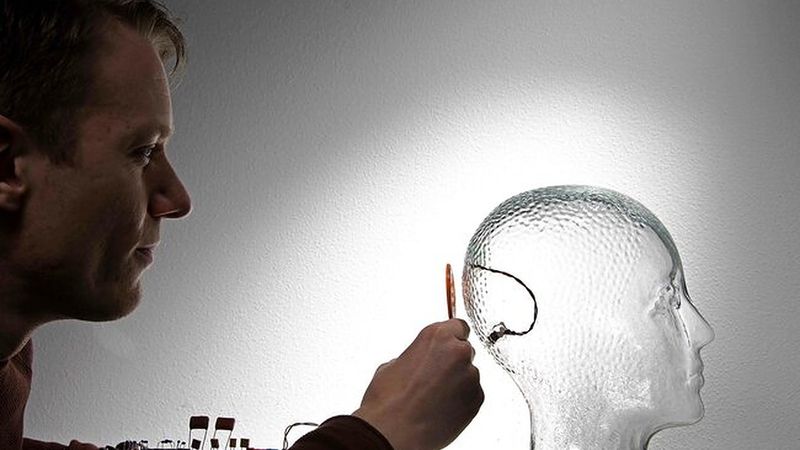Wireless power makes blind people see again
Tom van Nunen defended his thesis at the department of Electrical Engineering on February 8th, 2023.

Photo: Huib Visser
More than 43 million people worldwide are blind. In the past 30 years, that number has increased by roughly 50 percent. Most blind people are born with normal vision and lose their sight over time, due to medical causes or an accident. Often, the visual cortex in the brain is still capable of interpreting electrical signals, but the eyes or the connection between the eyes and brain are damaged or lost. It is possible to restore some form of sight by providing the right electrical signals to the visual cortex with an implant. PhD researcher Tom van Nunen has designed a wireless energy transfer system to safely and reliably connect to the implant, and developed a prototype.
Optical information is picked up by the eyes and sent with neuroelectric signals to the visual cortex in the brain. Interpreting this input is what people perceive as seeing. It is known that even blind people are able to perceive some visual cues when their cortex is stimulated by electrical signals.
By establishing a connection between an external image source, such as a camera, and electrodes implanted in the visual cortex, a blind individual can experience a crude form of vision with these visual stimuli.
The NESTOR project, of which Van Nunens’s research is part, aims to create such a visual prosthesis. The brain implant the team is currently developing includes systems for wireless data transfer, controlling the electrodes and wireless energy transfer, among other things.
Wireless connection
In his PhD research, Van Nunen focussed on the development of the wireless connection between the input device and the implant. A wireless connection is much more comfortable, flexible and safe for the user of the implant, but the question is: are they stable and powerful enough?
Miniaturization is a continuous development in the world of medical implants. Not only does this make existing applications smaller (~1 mm3), which has various advantages for the wearer of the implant in terms of comfort. It also reduces the medical complexity of inserting the implants in the body. However, this makes the implants too small to contain their own power source such as batteries. Therefore, the implants need to be powered through an wireless connection.
In the case of an implant of a few millimeters in size, placed at a depth of a few centimeters in the body, previous research suggests that the efficiency of wireless energy transfer is optimal at GHz frequencies. This operation regime is called midfield wireless power transfer (MF-WPT), where power is transferred using propagating waves, rather than induction.
Modelling optimal power transfer
Still, the expected efficiency in wireless power transfer to miniature implants remains rather low. Using an alternative approach, Van Nunen found that maximizing received power is a better approach than maximizing efficiency to get the desired results. To determine the best frequencies to use, he used two analytical models to calculate the electromagnetic fields.
In his thesis, he describes how he extended the models to calculate the specific absorption rate (SAR-rate) of electromagnetic radiation in the human body, the received power, and total dissipated power in the tissue.
The data calculated with these models can be used to determine the maximum transmit power such that the SAR safety limits are not exceeded. It turns out that both the highest received power and the highest transfer efficiency are found at 10 kHz, a much lower frequency than suggested by previous research.
Biomedical phantoms
To validate his findings, the researcher used so-called biomedical phantoms, which mimic specific properties real human tissue, taking care to create materials whose dielectric properties are in the correct range and remain constant for an extended period of time.
Van Nunen offers several phantom recipes that are based on readily available ingredients, such as water, sugar and salt, and can be made with in a simple kitchen-like setup. What’s more, the properties of the phantoms he provides remain almost constant for at least ten days, making them very suitable for his tests.
Self-made sensor
The phantoms he developed and described are homogeneous materials. However, the human body isn’t homogeneous. In some cases it can be necessary to add other details into the mix to better mimic the location of an implant in the body. The presence of our skull and teeth may for instance impact the way electromagnetic waves travel between the external device and the implant.
One approach is to add artificial bones to the phantom, for example created with 3D-printing technology. Using a cheap self-made sensor, Van Nunen was able to measure the dielectric properties of several commercially available 3D-printing filaments.
Some of these materials have dielectric properties that are close to those of bone for certain frequency bands, and can thus be used in biomedical experiments.
Title of PhD thesis: Wireless Power Transfer for Implantable Medical Devices. Supervisors: Huib Visser, Mark Bentum and Rob Mestrom.
This article was first published here: https://www.tue.nl/en/news-and-events/news-overview/08-02-2023-wireless-power-makes-blind-people-see-again/
